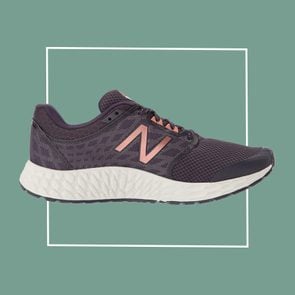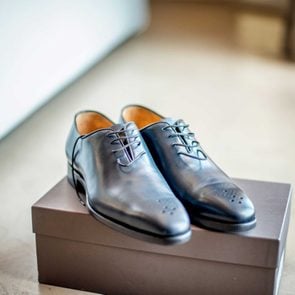10 Best Shoes for Bunions, According to Podiatrists
Updated: Mar. 30, 2021
Your footwear choices can make a huge difference in bunion pain. Here's what doctors recommend looking for in a pair of shoes, plus the 10 best shoes for women and men with bunions.
Our editors and experts handpick every product we feature. We may earn a commission from your purchases.
What are bunions?
Your big toe has an important job: When you take a step, it’s the last part of your foot that pushes off the ground to propel you forward. If the way you walk puts more stress on the big toe than it’s prepared to take on, a bunion can form.
A bunion is a common foot deformity that happens when the big toe starts to lean toward the other toes and a bump forms at the joint where the toe meets the foot. Estimates suggest that about one-third of people over the age of 65 have a bunion, though younger people get them, too.
Bunions aren’t always painful, but when they are, they can cause a deep ache or a sharp, severe pain that’s usually worse when you put weight on it or press on it, says Houman Danesh, MD, director of integrative pain management for The Mount Sinai Hospital in New York City.
Bunions typically form slowly, as repetitive pressure on the foot changes the shape of the bone over the course of years. While anyone can get a bunion, some people are more prone to the condition.
(These are common foot problems and podiatrists’ solutions.)
Why are some people prone to bunions?
Despite common belief, poorly fitting shoes aren’t the main cause of bunions. But they certainly contribute to bunion development and make already-existing bunions worse.
“Genetics is a primary driving point,” says Zachary Flynn, DPM, a podiatrist and fellowship-trained foot and ankle surgeon at Phoenix Spine & Joint in Arizona. A person’s foot type—whether you have high arches or flat feet—can also play a role.
According to the National Library of Medicine, people with weak connective tissue, a short Achilles’ tendon, short calf muscles, or joint diseases like rheumatoid arthritis have a higher risk of developing bunions. Women tend to get bunions more than men.
For many people, treatments like using toe spacers overnight, wearing wider and more supportive shoes, taking non-steroidal anti-inflammatory drugs (NSAID), and doing physiotherapy are sufficient for managing bunion pain. (Check out these recommended bunion correctors and learn how they work.)
If your bunions are causing you a lot of pain or if the deformity makes it hard to do certain activities or wear shoes, your doctor may recommend surgery. (Here’s more about the different types of bunions and how to treat them.)
How to make better shoe choices
Wearing supportive shoes that promote proper biomechanics—meaning, your foot moves in the way it’s supposed to—will stop you from putting an uneven amount of weight on the inside of your foot and contributing to bunion formation or exacerbating an existing bunion. For many people, a simple shoe switch-up relieves bunion pain and gets them back to the activities they enjoy.
(These are the best walking shoes for your feet.)
“Footwear choices are key,” says Amy Dunetz, DPM, a Florida-based podiatrist. Before buying shoes, it’s best to get your feet measured and fitted so you know exactly what size to buy to account for the bunion. Proper sizing, especially when it comes to width, is super important.
Some guidelines from Dr. Dunetz to keep in mind: Avoid pointy toe boxes. And skip very high heels, which put too much pressure on the forefoot. Look for shoes without straps or sides that go across the bunion, as they can press on it. Summer shoes shouldn’t be thin or flimsy; buy shoes with support and padding between your foot and the ground.
So, which shoes are tops? Dr. Flynn—who says he typically guides patients toward high-quality sneakers meant for endurance running—explains the five most important features to look for in shoes if you have bunions:
Stability and support
A good shoe should support your foot and help you maintain a neutral positioning and stride, says Dr. Flynn. “Stability: shoes usually have some sort of rail or guiding structure that’s meant to prevent your arches from collapsing and your foot from rolling inward, a condition called overpronation. Stabilizing the foot helps it move the way it’s supposed to and reduces the amount of force placed on the inside of your big toe as you push off the ground.
Shock absorption
Shoes with ample cushioning and high-quality soles help reduce the force put on your feet with every step. This, in turn, reduces the pressure that’s placed on your big toe and contributes to your bunion.
Wider fit
Dr. Flynn suggests looking for shoes that are either wider or come in multiple width options. “Wider shoes make it easier to accommodate an orthotic,” he says. The right width will also make sure your bunion isn’t pressing against the side of the shoe, causing you even more discomfort and contributing to the problem.
Flexible material around the toes
Look for shoes made with a mesh or otherwise flexible and breathable upper—the material on top of the toe box. “Leather is a very unforgiving material to put over a bunion,” Dr. Flynn says.
Arch support
A footbed that feels comfortable with your arch is important, too. The height of your arches will affect what you find comfortable and how much arch support you need. “Traditionally, a higher-arch foot needs more cushioning, and a flatter foot needs a stiffer shoe to support the foot because it’s more flexible,” Dr. Flynn says. “But most of the time, you just want a nice supportive, robust shoe with some cushioning on the inside.”
Best shoes for bunions
These shoes all meet the criteria that Dr. Dunetz and Dr. Flynn set out for shopping for shoes if you have bunions.
Just remember: These are suggestions that will likely work, but everyone’s feet are different and what works for one person might not work for another. The best course of action is to buy from a store that has a generous return policy and wear your new shoes around the house to determine if they work for you. If they don’t, return them and try something new.

Chacos Chillos Flip
$40
We know that flimsy flip-flops aren’t good for bunions, but what summer shoes are? Dr. Dunetz says that any summer sandals should still have good arch support. It’s also best to avoid straps going over the bunion area. These Chacos flip-flops for women and men are made with arch-support footbeds, which promote healthy alignment, and are accepted by the American Podiatric Medical Association.
(Here are some reasons why flip-flops may be bad for your feet.)

Vionic Women’s Lupe Flat Sandal
$110
These strappy sandals from Vionic manage comfort without totally sacrificing style. They’re made with a lightweight, flexible EVA midsole that’s meant to absorb shock from the ground and reduce the force put on your feet. The shoe is shaped to essentially hug and coddle your arches—you can think of it as a hidden orthotic that’s built right into your shoes for maximum support.

Altra Torin 4.5 Plush
$140
Altra’s Torin 4.5 Plush shoes are made with a larger toe box than most other sneakers, which makes them perfect for bunion relief. The zero-drop construction means the toe and heel are level, sitting at the same distance from the ground. This helps promote proper foot alignment and lessen the impact your forefoot absorbs from the ground.
The footpad is shaped to mimic natural foot alignment and includes cushy foam in the midsole that helps keep the arches and midfoot supported. Finally, the knit uppers around the toe box provide some flexibility for the toes to move around freely inside. There’s also a men’s version of Altra Torin shoes.
(These are the best summer shoes for flat feet.)

Brooks Glycerin GTS 19
$150
These running sneakers rank high in both the cushioning and structure departments. The Glycerin GTS 19‘s foam is cushy and responsive, absorbing shock with each step while also making your foot’s natural movement from heel to toe feel smooth. Structured guide rails along the sides of the shoe help promote proper foot movement and prevent the foot from rolling too far inward, a phenomenon called overpronation. The 3D-printed mesh upper is both stretchy and breathable, so your toes won’t feel constrained.
You can also get this pair of Glycerin GTS 19 shoes in men’s sizing.

Hoka One One Gaviota 3
$160
These sneakers are another great option for people looking for both cushion and stability to prevent overpronation. The midfoot has plenty of cushioning to absorb shock from the ground, but it’s a little firmer on the inside to create structure around the arch and keep the foot in proper alignment with each step. The shoe is also built to rock your foot forward so you don’t have to use as much force to push off your toes and propel yourself forward.
Hoka’s toe boxes tend to be a bit wider than other traditional running sneakers, and they have that mesh upper that’s so important for letting the toes breathe.
Hoka’s sneakers are also available in men’s.
(Here are the shoe mistakes that can cause foot pain.)

Birkenstock Unisex Arizona Leather Sandal
$100
Classic Birkenstock sandals are known for having contoured cork footbeds that form to the shape of your foot for top-notch arch support. An additional layer of foam underneath helps protect feet from impact. The sandals provide plenty of space for the toes and come in two width options (regular/wide and medium/narrow) so you can find the right fit. Individually adjustable straps add even more customization options.

New Balance 847 v4 Walking Shoe
$135
These New Balance sneakers come in an impressive five different widths, so you can make sure they are roomy enough for your feet. Stability posts built into the shoe stabilize the midfoot and the heel. The upper is made of soft and lightweight mesh, and the grippy outer sole makes these a good choice for outdoor walks. You can also try this pair of New Balance in men’s.
(Want to limit nerve damage and protect your feet? Try the best shoes for neuropathy.)

Topo Athletic Ultrafly 3
$130
Topo Athletic sneakers have a wide toe box that’s more in line with the natural shape of the feet, so toes can spread comfortably. They also have very minimal heel drop, which can help encourage a more natural gait and weight distribution across the foot, and light stability to reduce overpronation. The footbed has two layers of cushioning to pad the feet while preventing the foam from compressing, so you maintain some spring in your step.
These sneakers are also available in men’s sizing.

Allbirds Wool Runners
$95
Allbirds are made from merino wool, which means that they are really soft and stretch to accommodate your foot. From the toe to the heel, the entire upper is flexible and forgiving. The insole is cushioned, moisture-wicking, and odor-reducing, and if they do get stinky, you can throw the shoes in the washing machine. Bonus: Sustainable manufacturing practices make these sneaks carbon neutral. Allbirds come in men’s sizes, too.
(Stay comfy and cozy at home with the best slippers for your feet.)

Dr. Scholl’s Jayla Knit Slip-On
$100
It’s really hard to find comfortable flats in general, let alone if you’re trying to accommodate a bunion. Not only do these from Dr. Scholl’s come with an anatomical, cushioned footbed for arch support, but they’re also made of a knitted, flexible upper that won’t press or dig into your bunions. Extra cushioning in the heel helps you avoid the inevitable rubbing and blistering that tend to happen with flats.
Next, here are the feet health secrets you should know.




















